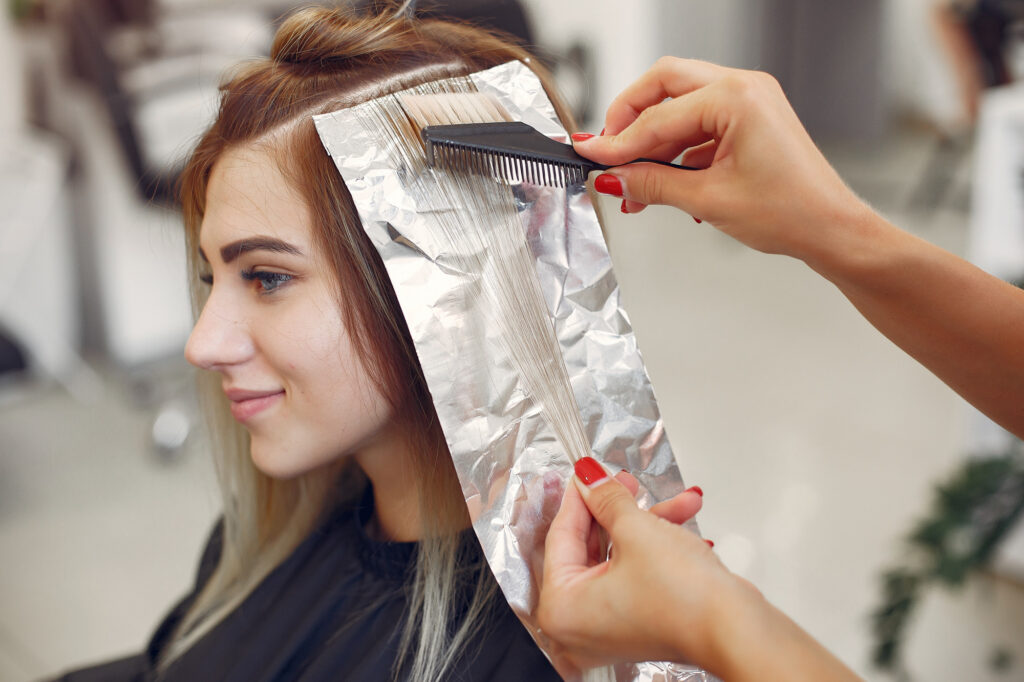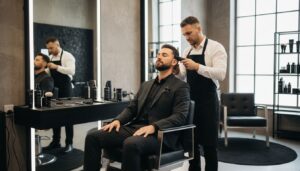Fine hair can feel like an impossible puzzle for styling. Even though it seems delicate and wispy, professional tips prove that layered cuts and the right products can make fine hair look up to 2x thicker. Most people believe fine hair is destined to remain flat, but the real secret is all about smart styling and a few strategic choices that completely transform its look and feel.
Table of Contents
- Choose The Right Cut For Fine Hair
- Layering Techniques To Add Volume
- Styling Products That Boost Thickness
- Effortless Updos For Fine Hair
- Creating Waves Without Heat Damage
- Accessories To Enhance Fine Hairstyles
- Maintenance Tips For Healthy Fine Hair
Quick Summary
| Takeaway | Explanation |
|---|---|
| Choose layers for volume | Layered cuts are essential for adding dimension and fullness to fine hair without weighing it down. |
| Utilize lightweight styling products | Use root-lifting sprays and mousses to enhance volume without heaviness. |
| Strategic updo techniques enhance volume | Loose styles and teasing can create fullness, making fine hair look more textured and elegant. |
| Practice heat-free wave techniques | Employ methods like overnight braiding to create waves without damaging fine hair. |
| Regular trims for health | Frequent trims help maintain the shape and prevent split ends, vital for fine hair’s health and appearance. |
1: Choose the Right Cut for Fine Hair
Finding the perfect hairstyle for fine hair requires strategic planning and understanding your unique hair texture. Fine hair demands specialized cutting techniques that create volume, movement, and the illusion of thickness. The right haircut can transform limp strands into a vibrant, dynamic style that looks fuller and more dynamic.
When selecting a cut for fine hair, professionals recommend focusing on techniques that maximize volume and minimize weight. Layered cuts are particularly effective for adding dimension and creating the appearance of fuller hair. Short to medium length styles often work best, as they prevent excessive weight from pulling hair down and reducing natural volume.
Key considerations for choosing the ideal fine hair cut include:
- Avoid heavy, blunt cuts that can make hair appear flat and lifeless
- Select cuts with soft, graduated layers that create natural movement
- Consider face shape and personal style when determining the most flattering approach
According to American Academy of Dermatology, texture plays a crucial role in determining the most suitable hairstyle. Lightweight, textured cuts work exceptionally well for fine hair because they create the illusion of thickness without adding unnecessary weight.
Professional stylists recommend consulting with an experienced hair artist who understands the nuanced techniques required for fine hair styling. A skilled stylist can assess your hair’s unique characteristics and recommend a personalized cut that enhances your natural texture while providing maximum volume and style.
Ultimately, the goal is to create a haircut that makes you feel confident and showcases the best qualities of your fine hair. By understanding the specific needs of your hair type and working with a knowledgeable professional, you can achieve a stunning look that celebrates your individual beauty.
2: Layering Techniques to Add Volume
Layering is a transformative technique for fine hair, offering an elegant solution to create visual fullness and dynamic movement. Understanding the art of strategic layering can dramatically enhance the appearance of thin hair, turning seemingly lifeless strands into a voluminous, textured masterpiece.
The key to successful layering lies in precision and strategic placement. Professional stylists use advanced cutting techniques that remove weight strategically while maintaining overall hair structure. By creating graduated layers of varying lengths, they generate natural lift and dimension that makes fine hair appear significantly thicker.
Critical layering considerations include:
- Create shorter layers around the crown to maximize root volume
- Use soft, textured cutting techniques instead of harsh, blunt lines
- Maintain longer bottom layers to preserve hair length and prevent a choppy appearance
According to Hair Professionals Magazine, micro-layering has emerged as a sophisticated approach for fine hair styling. This technique involves creating extremely subtle, interconnected layers that provide movement without compromising hair density.
Professional colorists and stylists recommend combining layering techniques with specialized styling products designed to enhance volume. Lightweight mousses, root-lifting sprays, and texturizing products can complement layered cuts, providing additional height and fullness.
The consultation process is crucial when planning layers for fine hair. An experienced hair artist will assess your hair’s unique characteristics, face shape, and personal style to design a customized layering approach. This personalized strategy ensures that layers work harmoniously with your natural hair texture, creating a look that feels both effortless and intentional.
Remember that layering is not a one-size-fits-all solution. Each individual’s hair responds differently to cutting techniques, making professional guidance essential in achieving the most flattering and voluminous result.
3: Styling Products That Boost Thickness
Fine hair requires specialized styling products that create volume without weighing strands down. Navigating the complex world of hair care products can be challenging, but understanding the right formulations can transform thin hair into a voluminous, vibrant style.
The most effective products for fine hair focus on lightweight, root-lifting technologies that provide immediate and lasting volume. Professionals recommend using a strategic combination of products that target different stages of styling to maximize hair thickness and texture.
Key product characteristics for fine hair include:
- Lightweight formulations that do not create product buildup
- Root-lifting sprays and mousses that provide instant volume
- Texturizing powders that add grip and dimension to hair
According to Cosmopolitan Hair Science Research, modern styling products have evolved to include advanced polymers and protein-based technologies that temporarily enhance hair shaft diameter. These innovative formulations create the illusion of thicker, fuller hair without causing long-term damage.
Professional stylists emphasize the importance of application technique. Applying products directly to the roots and using specific blow-drying methods can significantly amplify volume. Volumizing products work best when distributed evenly from roots to mid-lengths, creating a comprehensive approach to hair styling.
Consider investing in multi-functional products that offer both styling support and hair health benefits. Primers with keratin, heat protectants with thickening agents, and volumizing dry shampoos can provide multiple advantages for fine hair management.
The secret to successful fine hair styling lies in understanding your hair’s unique needs and selecting products that complement its natural texture. A personalized approach, guided by professional advice, ensures you can achieve a fuller, more dynamic hairstyle that looks and feels natural.
4: Effortless Updos for Fine Hair
Creating stunning updos for fine hair requires strategic techniques that add volume and prevent flat, lifeless styles. The right updo can transform thin hair into an elegant, sophisticated look that appears fuller and more dynamic.
Understanding the unique challenges of fine hair is crucial when designing updos. Lightweight techniques and strategic pinning can create the illusion of thickness and movement, allowing individuals with fine hair to confidently wear sophisticated hairstyles.
Essential considerations for fine hair updos include:
- Use texturizing products before styling to create additional grip
- Select loose, soft styles that create visual volume
- Incorporate strategic teasing to enhance fullness at the crown
According to Vogue Hairstyling Experts, modern updo techniques focus on creating soft, romantic styles that work with fine hair’s natural texture. Messy buns, soft chignons, and loose braided styles can be particularly flattering for those with fine hair.
Professional stylists recommend starting with dry shampoo or texturizing spray to provide additional grip and volume. These products create a foundation that helps pins and clips hold more effectively while generating the appearance of fuller hair. Backcombing techniques applied gently at the root can also provide instant lift and dimension.
The key to a successful updo for fine hair is creating the illusion of volume through strategic placement and styling. Soft, face-framing pieces and deliberately imperfect styling can make fine hair appear more voluminous and textured. Avoiding tight, slicked-back styles prevents hair from looking flat and lifeless.
Remember that practice and experimentation are essential. Each individual’s hair behaves differently, so what works for one person might not work perfectly for another. Patience and willingness to adapt your technique will help you discover the most flattering updo styles for your unique hair texture.
5: Creating Waves Without Heat Damage
Fine hair requires delicate handling to achieve beautiful waves without compromising its natural integrity. Heat styling can often cause significant damage, making alternative wave creation techniques essential for maintaining healthy, voluminous hair.
Natural wave formation techniques offer a gentle approach to creating texture and movement. These methods focus on minimizing structural stress while maximizing hair’s inherent potential for beautiful, soft waves. By understanding your hair’s unique characteristics, you can develop styling strategies that protect and enhance its natural beauty.
Key techniques for heat-free wave creation include:
- Utilize overnight braiding methods for soft, natural waves
- Experiment with silk or satin hair wrapping techniques
- Apply lightweight styling products that support natural wave formation
According to American Hair Science Institute, overnight styling methods can create lasting waves without the thermal stress associated with traditional heat styling. Techniques like pin curling, rag rolling, and twisted bun methods provide versatile alternatives for fine hair textures.
Professional stylists recommend preparing hair with lightweight, moisturizing products that support wave formation. Sea salt sprays and lightweight mousses can provide additional texture and hold without weighing down fine hair. The key is selecting products that enhance natural movement while providing subtle support.
Moisture management plays a crucial role in successful heat-free wave creation. Fine hair tends to be more susceptible to environmental factors, so using silk pillowcases and microfiber towels can help reduce friction and maintain wave definition. These protective techniques minimize damage while supporting your hair’s natural texture.
Experimentation is essential in discovering the most flattering wave techniques for your unique hair type. What works perfectly for one person might require slight modification for another. Patience and gentle handling will help you develop a personalized approach to creating beautiful, voluminous waves without compromising your hair’s health.
6: Accessories to Enhance Fine Hairstyles
Fine hair requires strategic accessorizing to create volume, texture, and visual interest. The right accessories can transform lifeless strands into a dynamic, stylish look that celebrates your hair’s unique characteristics.
Choosing accessories for fine hair demands a nuanced approach that prioritizes lightweight, volume-enhancing elements. Professional stylists recommend selecting pieces that add dimension without creating additional weight or causing breakage.
Essential considerations for fine hair accessories include:
- Select lightweight clips and pins that provide gentle support
- Choose accessories with textured surfaces for enhanced grip
- Opt for volumizing headbands that create lift at the crown
According to Hair Accessory Trends Magazine, modern hair accessories are designed with fine hair textures in mind. Innovative materials and design techniques now offer solutions that provide both aesthetic appeal and functional support.
Silk scrunchies, velvet hair ties, and soft fabric headbands work exceptionally well for fine hair. These materials minimize friction and prevent unnecessary breakage, allowing you to style your hair without compromising its delicate structure. Avoid tight elastic bands or heavy metal clips that can pull and damage fragile strands.
Texture-enhancing accessories like lightweight hair powders, dry shampoo, and volumizing sprays can complement physical accessories. These products create additional grip and lift, helping hair accessories stay in place while generating the appearance of fuller, more voluminous hair.
The key is to experiment and find accessories that not only look beautiful but also support your hair’s natural texture. Each individual’s hair responds differently to styling elements, so patience and creativity are essential in discovering your perfect accessory combination. Remember that confidence is the most important accessory you can wear.
7: Maintenance Tips for Healthy Fine Hair
Maintaining fine hair requires a delicate balance of gentle care and strategic treatment techniques. Understanding the unique characteristics of fine hair is crucial in developing a comprehensive maintenance routine that preserves its health and enhances its natural beauty.
Professional hair care experts emphasize the importance of a holistic approach to fine hair maintenance. Protecting hair from environmental damage and minimizing structural stress are paramount in preserving its integrity and volume.
Key maintenance strategies for fine hair include:
- Use sulfate-free, lightweight shampoos that do not strip natural oils
- Implement weekly deep conditioning treatments with protein-based products
- Minimize heat styling and always use protective thermal products
According to Trichology Research Center, fine hair requires specialized care due to its delicate structure. The protein composition and diameter of fine hair make it more susceptible to damage from environmental factors and styling techniques.
Nutrition plays a critical role in hair health. Consuming protein-rich foods, omega-3 fatty acids, and maintaining proper hydration can significantly improve hair strength and texture. Supplements containing biotin, collagen, and vitamins A, C, and E can support hair growth and resilience.
Professional treatments like keratin treatments and protein reconstructors can temporarily enhance hair’s structural integrity. These specialized services help rebuild hair’s protein structure, creating a protective barrier that reduces breakage and improves overall hair health.
Regular trims are essential for fine hair maintenance. Removing split ends prevents further damage and helps maintain the hair’s natural volume and movement. Working with a professional stylist who understands fine hair’s unique requirements ensures you receive personalized care tailored to your specific hair needs.
Below is a comprehensive table summarizing the seven chic hairstyle strategies and core takeaways for fine hair discussed in the article.
| Topic | Key Points & Strategies | Benefits for Fine Hair |
|---|---|---|
| Right Cut for Fine Hair | Choose layered, lightweight, short to medium cuts tailored to texture and face shape | Adds volume and movement; prevents flatness |
| Layering Techniques to Add Volume | Use micro-layering, soft texture, and graduated layers around the crown | Creates fullness and thicker appearance |
| Styling Products That Boost Thickness | Select lightweight mousses, root-lifting sprays, and volumizing/texturizing powders | Instantly boosts volume without buildup |
| Effortless Updos for Fine Hair | Opt for loose styles, backcombing, use texturizing products for grip, and avoid slicked-back styles | Achieves elegant, fuller-looking updos |
| Creating Waves Without Heat Damage | Try overnight braiding, silk wraps, or gentle styling products like sea salt sprays | Protects hair and creates natural waves |
| Accessories to Enhance Fine Hairstyles | Use lightweight and textured accessories, silk scrunchies, soft headbands, volumizing sprays for extra grip & lift | Adds visual interest and prevents breakage |
| Maintenance Tips for Healthy Fine Hair | Wash with sulfate-free products, deep condition, minimize heat, eat a nutrient-rich diet, supplement as needed, trim regularly | Preserves health, prevents split ends, supports volume |
Transform Fine Hair with Pro Styling from Joel C Ma Hair Studio
Do you feel frustrated by limp, flat strands or find it hard to create lasting volume and fullness for your fine hair? This guide on chic hairstyles for fine hair highlights the struggle to maintain body, style, and movement—issues that require expert care and precision techniques. At Joel C Ma Hair Studio, our team specializes in advanced layering, volumizing updos, and personalized haircuts that bring out the best in every hair type. See for yourself how our creative solutions make a difference by exploring the Uncategorized Archives for inspiring transformations and expert tips.

Ready to give your fine hair new life and lasting volume? Book a one-on-one consultation or explore our tailored services at Joel C Ma Hair Studio today. Take the first step toward the style and confidence you deserve with specialized care from artists who understand your unique hair needs.
Frequently Asked Questions
What are the best hairstyles for fine hair?
Fine hair benefits from hairstyles that add volume and texture. Consider layered cuts, messy buns, or soft waves to create the illusion of thickness and fullness. Experiment with different lengths and styles to find what works best for your hair type.
How can I create volume for fine hair updos?
To create volume in updos for fine hair, use texturizing products and opt for soft, loose styles. Techniques like gentle teasing at the crown can enhance lift, while using accessories like volumizing headbands can maintain the style. Practice different placements to achieve your desired look.
What products are best for styling fine hair?
Select lightweight, root-lifting products like mousses or sprays that provide volume without weighing your hair down. Applying these products from the roots through mid-lengths can improve the overall texture and thickness of your hairstyle. Look for products specifically designed for fine hair to maximize results.
How do I style fine hair without heat?
To style fine hair without heat, try techniques like overnight braiding or using silk wraps to create soft waves. Apply a lightweight styling product to maintain wave definition and reduce frizz. This method can help you achieve natural-looking waves while protecting your hair’s integrity.
What hairstyles work best for my fine hair texture?
Choose hairstyles that enhance your fine hair texture, such as layered cuts, soft curls, and effortless updos. Consult with a stylist to determine which styles flatter your face shape and lifestyle, ensuring a customized approach to your hair’s unique characteristics.
How often should I trim fine hair for optimal maintenance?
Trimming fine hair every 6–8 weeks helps prevent split ends and maintain volume and movement. Regular trims not only enhance the appearance of your hairstyle but also promote healthier hair growth overall. Schedule appointments with a stylist who understands the needs of fine hair to ensure the best outcome.





